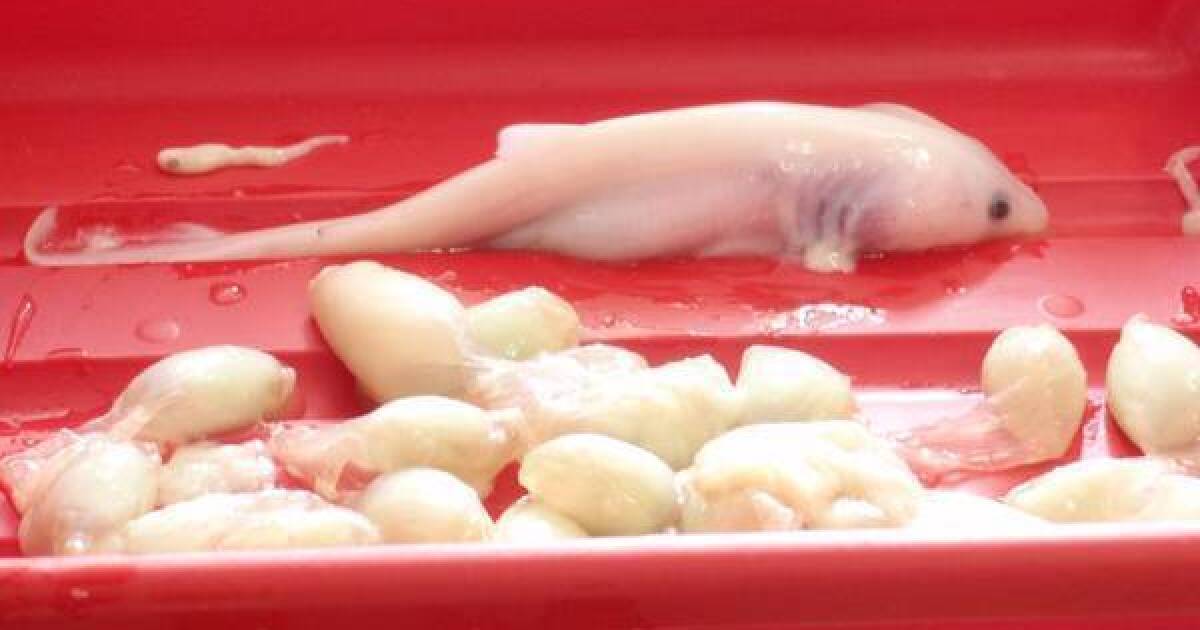The natural world is replete with fascinating and often brutal survival strategies, and the sand tiger shark (Carcharias taurus) stands out as a particularly extreme example. This species exhibits a rare and gruesome reproductive behavior known as intrauterine cannibalism, where multiple embryos develop within the mother’s womb, engaging in a fierce battle for survival. Ultimately, only the strongest and most voracious embryo emerges, having consumed its siblings to secure its place in the ocean.

Image Source: https://i.natgeofe.com/n/8c305689-0d92-4158-8a39-b5656824b514/Sand-tiger-shark.jpg?w=2560&h=1248
A Unique Reproductive Strategy
Sand tiger sharks, also known as grey nurse sharks or ragged-tooth sharks, are found in temperate and tropical coastal waters around the globe. They are easily recognizable by their robust bodies, protruding teeth, and fierce appearance. Despite their menacing look, they are generally harmless to humans. However, their reproductive behavior tells a different story of violence and survival. Unlike many fish that release eggs into the water for external fertilization, sand tiger sharks engage in internal fertilization. Females have two uteri, and during the breeding season, they mate with multiple males. This results in the fertilization of numerous eggs in each uterus.

Image Source: https://images.squarespace-cdn.com/content/v1/Sand+Tiger+Shark+Ovophagy_Judy+C+Design+2.jpg
The early stages of embryonic development in sand tiger sharks are unremarkable, with multiple embryos growing within each uterus. However, a drastic shift occurs as the embryos reach a certain size. One embryo in each uterus begins to assert dominance, growing larger and developing more quickly than its siblings. This dominant embryo then starts consuming the others in a brutal process known as embryophagy or intrauterine cannibalism. Intrauterine cannibalism among sand tiger sharks is a stark example of Darwinian natural selection at work. The dominant embryo consumes not only the yolk reserves provided by the mother but also the smaller, weaker embryos within the uterus. This process ensures that the surviving embryo has access to an abundant supply of nutrients, allowing it to grow stronger and more robust. By the time it is ready to be born, it is a formidable predator, well-equipped to face the challenges of the ocean.

Image source: https://www.latimes.com/science/la-xpm-2013-may-03-la-sci-sn-tiger-sand-shark-20130502-story.html
This brutal reproductive strategy confers several advantages. First, it ensures that the offspring are born larger and stronger, increasing their chances of survival in the wild. Second, by producing fewer, but more robust, offspring, the mother conserves energy and resources, enhancing her own survival and future reproductive success. Finally, this strategy may reduce predation risk on the newborns, as larger and more developed pups are better able to fend for themselves immediately after birth. The phenomenon of intrauterine cannibalism in sand tiger sharks provides valuable insights into the complexities of evolutionary biology and reproductive strategies. It highlights the diversity of survival mechanisms in the animal kingdom and underscores the relentless drive for survival that characterizes all life forms. This reproductive behavior also poses interesting questions for researchers. For instance, how do the embryos recognize and target their siblings? What triggers the dominant embryo to start consuming its kin? Further study into these questions could shed light on the intricate balance of competition and cooperation in the development of animal life.

Image source: https://i.cbc.ca/1.1383869.1378967360!/httpImage/image.jpg_gen/derivatives/16x9_940/hi-852-sand-tiger-shark-9721238.jpg
The sand tiger shark’s intrauterine cannibalism is a stark reminder of nature’s often brutal methods for ensuring the survival of the fittest. This extraordinary reproductive strategy underscores the relentless and sometimes savage nature of evolutionary processes. Through this lens, the sand tiger shark stands as a powerful symbol of resilience and the unyielding drive for survival in the natural world.
References:
1. National Geographic.. https://www.nationalgeographic.com/animals/fish/facts/sand-tiger-shark
2. Florida Museum of Natural History. https://www.floridamuseum.ufl.edu/discover-fish/species-profiles/carcharias-taurus/
3. BBC Earth. https://www.bbcearth.com/blog/?article=the-cannibal-sharks-of-north-america
4. Live Science. https://www.livescience.com/63763-sand-tiger-shark-cannibalism.html










